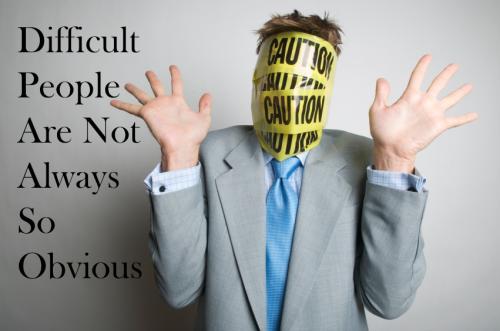 It seems to happen in a lot of workplaces. Someone is difficult. It can be a client, peer or (gulp) your boss. Or it could be that incommunicative guy in the mailroom, the gossipy sales person, the surly receptionist or the aggressive fill-in-the-blank that puts a crimp in your day.
It seems to happen in a lot of workplaces. Someone is difficult. It can be a client, peer or (gulp) your boss. Or it could be that incommunicative guy in the mailroom, the gossipy sales person, the surly receptionist or the aggressive fill-in-the-blank that puts a crimp in your day.
Might be that new Gen Y that asks too many questions, texts too much and talks too little. ENTITLEMENT! Could be the very direct Gen X who leaves the desk at 5 PM with work still to be done. UNCOMMITTED! How about that Baby Boomer who called the two hour meeting so she could introduce a new process and all you’re concerned about is getting to the bottom line? TALK, NO ACTION!
In workshops I have conducted it is evident that the concept of being difficult is user-defined. While there may be some similarities in types, what difficult means depends upon one’s own triggers. From, “He punched his fist through the wall!” to “She doesn’t say hello each morning,” difficult is relative. It behooves us to think of why the person triggers our reaction.
What is it…an attitude, a behavior or a lack of aptitude? Are they not doing their job? Are they trying to do yours? Is their energy too negative, too positive or too …blah? Identify your trigger so you can manage your own behavior.
Sounds simple enough, but the truth is that many want some magic bullet for getting along with them or simply have them disappear. Since door number two is unlikely, let’s deal with door number one. According to the authors of “Dealing with People You Can’t Stand”, Dr. Rick Brinkman & Dr. Rick Kirschner, there are four approaches when coping with difficult people:
-
Do nothing
-
Walk away
-
Change your attitude
-
Change your approach in dealing with them
Nothing Doin’
Not a big fan of this approach although I do recognize there are times when avoidance is a good thing. When you don’t have time to deal with the issue, when it is inconsequential to your purpose or when you recognize it is better to lose this battle and win the war.
I’m Walking
Is this just another form of avoidance? If you are triggered and value the relationship, it can be a great idea! Walking away offers distance and the opportunity for more objectivity. Giving yourself room to look back and view the interchange from another vantage point can provide opportunities for learning and ideas for handling things differently the next time. I’d say walking away can be a good idea as long as you learn something as you move.
Change the ‘tude, dude
As the character Jack Sparrow in the Disney movie, Pirates of the Caribbean, stated “The problem is not the problem; your attitude about the problem is the problem.” Is this a difficult person or a difficult situation? Are you shellacking some people with the label of “difficult” when it is the situation we are in together or perhaps their own personal situation that is bleeding into the workplace that is difficult? Do you really believe folks are in the shower every morning trying to figure out ways to make other peoples’ lives hell?
I’d rather empathize with a person who is clearly unhappy. Perhaps life has taught them to be defensive, a tank or way too quiet. We don’t know and often enough we don’t try to understand why they are acting the way they are, the ways we see as difficult. We THINK we know but often we don’t bother to ask. Then we judge them incorrectly. Ouch. Perhaps it would be best if we make a commitment to finding a way to work better with the person. All is not lost if we change our own attitude. We control that part of the equation.
He’s Approaching the Green….Three Things to do Differently
Green signifies go. And as Kermit the Frog has admitted, “It’s not easy being green.” We need a different approach to make progress with our “difficult” people. What can we do?
1. Listen very carefully for the root cause.
What is really happening here? Don’t judge early or buy into someone else’s version of why this person is difficult. Difficult may just mean different. What really are the differences we have? Is it possible that we simply see the world through a different lens? That could be cultural, generational, or departmental, to name a few. We are bound to have different motivations. With a little more understanding about where people are coming from, we can make strides to have a less testy relationship.
2. Don’t take it personally.
Say ten times, “This is not about me” That’s so easy to write and yet we know in the heat of the moment, especially if we have been blind-sided, it is so hard to not get emotionally involved. We need to get centered and respond versus react.
3. Ask, “Hey, what’s this really about?”
Studies in strength-based leadership show us that staff want to know they matter. By changing our approach to one of genuine curiosity and service, we can help solve the problems that are creating the difficult circumstances. Try it. You may be surprised by the reaction of your difficult person when they realize you genuinely care about creating a better working relationship with them.
Conclusion
Consider the difficult relationship as an opportunity for learning. Sure, there will be people that rub us wrong. We have a choice on how we view this – as a monumental pain in the tush or a time for self-reflection on our triggers and the development of healthier ways to connect. Work gets done through relationships. Relating takes skills and energy. Dealing with difficult people does not need to be that difficult and can be the beginning of an admired and desired skillset in today’s multigenerational, multicultural workplace.
 Written by Sherri Petro, President of VPI Strategies & California Miramar University (CMU) Professor Sherri is a professor, accomplished strategist, organizational development professional and executive coach. She consulted for 13 years in the for-profit, non-profit, and government sectors after a 16 year corporate career. She teaches the Strategy Capstone as well as Leadership, Change Management and Business Ethics courses in CMU’s MBA program. Her current passion is educating organizations on how to increase organizational sustainability by leveraging the talents and skills of all in multi-generational workplaces. Sherri offers remedies to misunderstandings that result from different belief structures and lack of coherent communication by creating understanding and making connections at the belief level not only at the behavioral level.
Written by Sherri Petro, President of VPI Strategies & California Miramar University (CMU) Professor Sherri is a professor, accomplished strategist, organizational development professional and executive coach. She consulted for 13 years in the for-profit, non-profit, and government sectors after a 16 year corporate career. She teaches the Strategy Capstone as well as Leadership, Change Management and Business Ethics courses in CMU’s MBA program. Her current passion is educating organizations on how to increase organizational sustainability by leveraging the talents and skills of all in multi-generational workplaces. Sherri offers remedies to misunderstandings that result from different belief structures and lack of coherent communication by creating understanding and making connections at the belief level not only at the behavioral level.
Do you have a question for Sherri? Please visit our Workplace Communication Skills Community, she will be happy to help: Ask an Expert
About ManagingAmericans.com
Organizational Strategy & Teambuilding Tools for Business Leaders & Managers- helping leaders achieve profitable results w/ fewer resources & happier employees. Our well-rounded business content is designed for leaders & managers to implement change with ease & improve accountability amongst their teams.